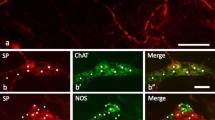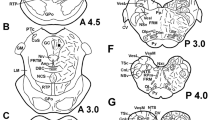Summary
A close spatial relationship between serotonin-containing mast cells and substance P-containing nerves was shown by immunohistochemistry using a combination of antisera specific for serotonin and substance P. This supports earlier morphological results suggesting an innervation of mast cells and pharmacological studies which postulate an influence of substance P on the release of histamine from mast cells.
Similar content being viewed by others
References
Arvier PT, Chahl LA, Ladd RJ (1977) Modification by capsaicin and compound 48/80 of dye leakage induced by irritants in the rat. Br J Pharmacol 59: 61–68
Coons AH (1958) Fluorescent antibody methods. In: Danielli JF (ed) General cytochemical methods. Academic Press, New York, pp 399–422
Costa M, Buffa R, Furness JB, Solcia E (1980) Immunohistochemical localization of polypeptides in peripheral autonomic nerves using whole mount preparations. Histochemistry 65: 157–165
Cuello AC, Polak JM, Pearse AGE (1976) Substance P: a naturally occurring transmitter in human spinal cord. Lancet 13: 1054–1056
Cuello AC, Del Fiacco M, Paxinos G (1978) The central and peripheral ends of the substance P containing sensory neurones in the rat trigeminal system. Brain Res 152: 499–509
Erjavec F, Lembeck F, Florjanc-Irman T, Skofitsch G, Donner J, Saria A, Holzer P (1981) Release of histamine by substance P. Naunyn-Schmiedeberg's Arch Pharmacol 317: 67–70
Fewtrell CMS, Foreman JC, Jordan CC, Oehme P, Renner H, Stewart JM (1982) The effect of substance P on histamine and 5-hydroxytryptamine release in the rat. J Physiol 330: 393–411
Fjellner B, Hägermark O (1981) Studies on puritogenic and histamine-releasing effects of some putative peptide neurotransmitters. Acta Dermatol Venerol 61: 245–250
Foreman JC, Jordan CC (1980) Comparison of the activities of some peptides in human skin and as histamine releasing agents. Proc Br Pharmacol Soc (London) C57: 55
Gamse R, Holzer P, Lembeck F (1980) Decrease of substance P in primary afferent neurones and impairment of neurogenic plasma extravasation by capsaicin. Br J Pharmacol 68: 207–213
Heine H, Förster FJ (1975) Relationship between mast cells and preterminal nerve fibers. Z Mikrosk Anat Forsch 89: 934–937
Hökfelt T, Kellerth JO, Nilsson G, Pernow B (1975) Experimental immunohistochemical studies on the localization and distribution of substance P in cat primary sensory neurones. Brain Res 100: 235–252
Jabonero N (1959) Die plexiforme Synapse auf Distanz und die Bedeutung der sogenannten interkalären Zellen. Acta Neuroveg 19: 276–303
Johnson AR, Erdös EG (1973) Release of histamine from mast cells by vasoactive peptides. Proc Soc Exp Biol Med 142: 1252–1256
Keller R (1958) Zur Bindung von Histamin und Serotonin in den Mastzellen. Arzneim Forsch 8: 390
Kerouac R, St-Pierre S, Rioux F (1984) Histamine release by neurotensin in the rat hindquarter: Structure-activity studies. Peptides 5: 695–699
Kiernan JA (1977) A study of chemically induced acute inflammation in the skin of the rat. Q J Exp Physiol 62: 151–161
Kitada C, Ashida Y, Maki Y, Fujino M, Hirai Y, Yasuhara T, Nakajima T, Takeyama M, Koyama K, Yajima H (1980) Synthesis of granuliberin-R and various fragment peptides and their histamine-releasing activities. Chem Pharm Bull 28: 887–892
Lembeck F (1982) Substance P and the primary afferent neuron. In: Yoshida H, Hagihar Y, Ebashi S (eds) Advances in pharmacology and therapeutics II. Pergamon Press, New York, pp 115–126
Lembeck F, Donnerer J (1981) Postocclusive cutaneous vasodilatation mediated by substance P. Naunyn-Schmiedeberg's Arch Pharmacol 316: 165–171
Lembeck F, Holzer P (1979) Substance P as neurogenic mediator of antidromic vasodilation and neurogenic plasma extravasation. Naunyn-Schmiedeberg's Arch Pharmacol 310: 175–183
Lembeck F, Donnerer J, Barthö L (1982) Inhibition of neurogenic vasodilatation and plasma extravasation by substance P-antagonists, somatostatin, and (D-Met2, Pro5)-enkephalinamide. Eur J Pharmacol 85: 171–176
Lehtosalo JI, Uusitalo H, Laakso J, Palkama A, Härkönen M (1984) Biochemical and immunohistochemical determination of 5-hydroxytryptamine located in mast cells in the trigeminal ganglion of the rat and guinea pig. Histochemistry 80: 219–223
Morton CR, Chahl LA (1980) Pharmacology of the neurogenic oedema response to electrical stimulation of the saphenous nerve in the rat. Naunyn-Schmiedeberg's Arch Pharmacol 314: 271–276
Newson B, Dahlström A, Enerbäck L, Ahlman H (1983) Suggestive evidence for a direct innervation of mucosal mast cells. An electron microscopic study. Neuroscience 10: 565–570
Riley JF, West GB (1958) 5-hydroxytryptamine in mast cells. Ann NY Acad Sci 73: 204
Rosell S, Olgart L, Gazelius B, Panopoulos P, Folkers K, Hörig J (1981) Inhibition of antidromic and substance P-induced vasodilatation by a substance P antagonist. Acta Physiol Scand 111: 381–382
Saria A (1984) Substance P in sensory nerve fibres contributes to the development of oedema in the rat hind paw after thermal injury. Br J Pharmacol 82: 217–2222
Skofitsch G, Donnerer J, Petronijevic S, Saria A, Lembeck F (1983) Release of histamine by neuropeptides from the perfused rat hindquarter. Naunyn-Schmiedeberg's Arch Pharmacol 322: 153–157
Stach W (1961) Morphologische Beziehungen zwischen Mastzellen und vegetativer Endformation. Z Mikrosk Anat Forsch 67: 257–280
Stach W, Weiss R, Radke R (1975) Licht- und elektronenmikroskopische Untersuchungen über die Nervengeflechte der Magenschleimhaut und deren Beziehungen zu Beleg- und Mastzellen. Dtsch Z Verdauungs-Stoffwechselkr 35: 205–218
Uvnäs B (1965) Der Mechanismus der Histaminfreisetzung aus Mastzellen. Naunyn-Schmiedeberg's Arch Pharmacol 250: 137–149
Wiesner-Menzel L, Schulz B, Vakilzadeh F, Czarnetzki BM (1981) Electron microscopical evidence for a direct contact between nerve fibres and mast cells. Acta Dermatovener (Stockholm) 61: 465–469
Author information
Authors and Affiliations
Additional information
International Research Fellow, awarded by Fogarty International Center, Fellowship number 1 FO5 TWO 3293-01 BI
Rights and permissions
About this article
Cite this article
Skofitsch, G., Savitt, J.M. & Jacobowitz, D.M. Suggestive evidence for a functional unit between mast cells and substance P fibers in the rat diaphragm and mesentery. Histochemistry 82, 5–8 (1985). https://doi.org/10.1007/BF00502084
Accepted:
Issue Date:
DOI: https://doi.org/10.1007/BF00502084




